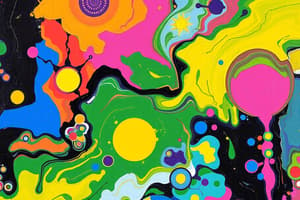Podcast
Questions and Answers
Match each phase change with its correct definition:
Match each phase change with its correct definition:
Melting = The change from solid to liquid. Evaporation = The change from liquid to gas. Condensation = The change from gas to liquid. Solidification = The change from liquid to solid. Sublimation = The change from solid to gas without passing the liquid state.
Match the following examples with the type of change they represent:
Match the following examples with the type of change they represent:
Burning Wood = Chemical Change Melting Ice = Physical Change Rusting of Iron = Chemical Change Boiling Water = Physical Change
Associate each evidence with the type of chemical reaction it indicates:
Associate each evidence with the type of chemical reaction it indicates:
Formation of Bubbles = Evolution of Gas Change in Color = Change in Intrinsic Property Release of Heat = Temperature Change Formation of a Solid = Formation of Precipitate Emission of Light = Production of Light
Match the following real-world examples to whether they represent physical or chemical changes:
Match the following real-world examples to whether they represent physical or chemical changes:
Connect the characteristics with either physical or chemical changes:
Connect the characteristics with either physical or chemical changes:
Flashcards
What is a physical change?
What is a physical change?
A change that doesn't produce a new substance; the material's appearance changes, but it's still the same substance.
What is melting point?
What is melting point?
The temperature at which a substance changes from a solid to a liquid.
What is evaporation?
What is evaporation?
The process where a liquid turns into a gas due to increased energy, allowing molecules to break free.
What is condensation?
What is condensation?
Signup and view all the flashcards
What is a chemical change?
What is a chemical change?
Signup and view all the flashcards
Study Notes
- Physical and chemical changes are explored.
Physical Change
- A physical change does not create a new substance.
- The material remains the same, but with a different appearance.
- Ice melting into water is a physical change.
- The substance remains water (H₂O), but changes from solid to liquid.
- The melting point is the temperature at which a solid turns to liquid.
- Evaporation is when a liquid turns into a gas.
- Evaporation occurs when molecules gain enough energy to break free from a liquid's surface and become a gas.
- Condensation is the process when a liquid forms from gas or vapor.
- Water vapor condenses when moist air is cooled below its dew point.
- Dew point is the temperature at which moist air becomes saturated and forms dew.
- Solidification, or freezing, is when a liquid turns into a solid.
- Solidification happens when the temperature decreases to its freezing point.
- During solidification, molecules lose energy and arrange into a more structured, solid form.
- Sublimation is a change of state from solid to gas without passing the liquid state.
- Sublimation occurs when the molecules of a solid gain enough energy to overcome their fixed positions and enter the gaseous state.
Chemical Change
- A chemical change transforms substances into new and different ones.
- Unlike physical changes, chemical changes form new materials with different properties.
- Chemical reactions are processes where chemicals interact to form new chemicals with different compositions.
- New substances are formed as a characteristic of chemical change.
- Gas, heat, light, or solids (precipitate) can be produced.
- Chemical changes are usually irreversible, and lead to large energy changes.
Evidences of Chemical Reaction
- Combustion is the process of burning wood or fossil fuels.
- Rusting is iron reacting with oxygen to form rust.
- Cooking/baking transforms raw ingredients into cooked food.
- Digestion breaks down food in the stomach to provide energy.
- Neutralization is when acid reacts with a base to form salt and water.
- Changes in Intrinsic Property occur during chemical changes.
- Production of light.
- Evolution of gas occurs due to a chemical change.
- Temperature Change can provide evidence of chemical reaction.
- Formation of Precipitate.
Studying That Suits You
Use AI to generate personalized quizzes and flashcards to suit your learning preferences.




